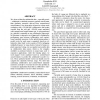Free Online Productivity Tools
i2Speak
i2Symbol
i2OCR
iTex2Img
iWeb2Print
iWeb2Shot
i2Type
iPdf2Split
iPdf2Merge
i2Bopomofo
i2Arabic
i2Style
i2Image
i2PDF
iLatex2Rtf
Sci2ools
103
click to vote
ISMIR
2005
Springer
2005
Springer
Improving Content-Based Similarity Measures by Training a Collaborative Model
We observed that for multimedia data – especially music - collaborative similarity measures perform much better than similarity measures derived from content-based sound features. Our observation is based on a large scale evaluation with >250,000,000 collaborative data points crawled from the web and >190,000 songs annotated with content-based sound feature sets. A song mentioned in a playlist is regarded as one collaborative data point. In this paper we present a novel approach to bridging the performance gap between collaborative and contentbased similarity measures. In the initial training phase a model vector for each song is computed, based on collaborative data. Each vector consists of 200 overlapping unlabelled 'genres' or song clusters. Instead of using explicit numerical voting, we use implicit user profile data as collaborative data source, which is, for example, available as purchase histories in many large scale ecommerce applications. After the training ...
Related Content
| Added | 27 Jun 2010 |
| Updated | 27 Jun 2010 |
| Type | Conference |
| Year | 2005 |
| Where | ISMIR |
| Authors | Richard Stenzel, Thomas Kamps |
Comments (0)

